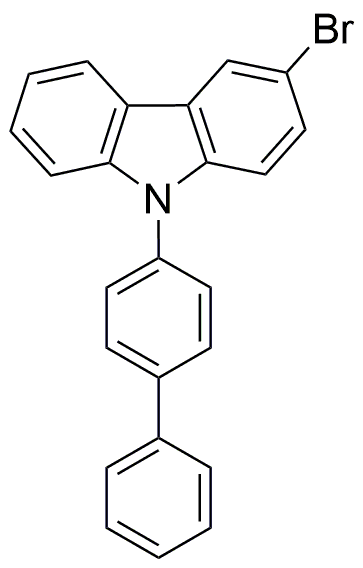9-(4-Biphenylyl)-3-bromocarbazole is widely utilized in research focused on:
- Organic Electronics: This compound is a key material in the development of organic light-emitting diodes (OLEDs), providing high efficiency and improved color purity in displays.
- Photovoltaic Cells: It serves as a donor material in organic solar cells, enhancing energy conversion efficiency and stability, making solar technology more accessible and effective.
- Fluorescent Sensors: The compound is employed in creating fluorescent sensors for detecting environmental pollutants, offering a sensitive and reliable method for monitoring air and water quality.
- Pharmaceutical Research: Its unique structure is explored in drug development, particularly for targeting specific biological pathways, which can lead to more effective treatments with fewer side effects.
- Polymer Science: It is used in the synthesis of advanced polymers that exhibit desirable optical and electronic properties, paving the way for innovative materials in various applications.
General Information
Properties
Safety and Regulations
Applications
9-(4-Biphenylyl)-3-bromocarbazole is widely utilized in research focused on:
- Organic Electronics: This compound is a key material in the development of organic light-emitting diodes (OLEDs), providing high efficiency and improved color purity in displays.
- Photovoltaic Cells: It serves as a donor material in organic solar cells, enhancing energy conversion efficiency and stability, making solar technology more accessible and effective.
- Fluorescent Sensors: The compound is employed in creating fluorescent sensors for detecting environmental pollutants, offering a sensitive and reliable method for monitoring air and water quality.
- Pharmaceutical Research: Its unique structure is explored in drug development, particularly for targeting specific biological pathways, which can lead to more effective treatments with fewer side effects.
- Polymer Science: It is used in the synthesis of advanced polymers that exhibit desirable optical and electronic properties, paving the way for innovative materials in various applications.
Documents
Safety Data Sheets (SDS)
The SDS provides comprehensive safety information on handling, storage, and disposal of the product.
Product Specification (PS)
The PS provides a comprehensive breakdown of the product’s properties, including chemical composition, physical state, purity, and storage requirements. It also details acceptable quality ranges and the product's intended applications.
Certificates of Analysis (COA)
Search for Certificates of Analysis (COA) by entering the products Lot Number. Lot and Batch Numbers can be found on a product’s label following the words ‘Lot’ or ‘Batch’.
*Catalog Number
*Lot Number
Certificates Of Origin (COO)
This COO confirms the country where the product was manufactured, and also details the materials and components used in it and whether it is derived from natural, synthetic, or other specific sources. This certificate may be required for customs, trade, and regulatory compliance.
*Catalog Number
*Lot Number
Safety Data Sheets (SDS)
The SDS provides comprehensive safety information on handling, storage, and disposal of the product.
DownloadProduct Specification (PS)
The PS provides a comprehensive breakdown of the product’s properties, including chemical composition, physical state, purity, and storage requirements. It also details acceptable quality ranges and the product's intended applications.
DownloadCertificates of Analysis (COA)
Search for Certificates of Analysis (COA) by entering the products Lot Number. Lot and Batch Numbers can be found on a product’s label following the words ‘Lot’ or ‘Batch’.
*Catalog Number
*Lot Number
Certificates Of Origin (COO)
This COO confirms the country where the product was manufactured, and also details the materials and components used in it and whether it is derived from natural, synthetic, or other specific sources. This certificate may be required for customs, trade, and regulatory compliance.


